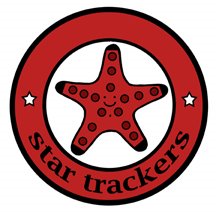... AND WHY WE SHOULD TRACK THEM.
Protoreaster nodosus (Linneaus 1758), commonly known as knobbly seastar or horned seastar, is a large asteroid that has large nodules or tubercles on the aboral surface (Lane and Vandenspiegel 2003). It is usually coloured in red or pink, but has also been found in other colours such as crimson, white, blue, green, grey, beige and light brown (Chew 1993; Lane and Vandenspiegel 2003).
This echinoderm occurs in large populations in the Indo-Pacific, particularly on seagrass beds (Lane and Vandenspiegel 2003). However, the conservation status of this charismatic animal is recognised as endangered in Singapore (Ng & Wee, 1994). Recruitment in local populations was believed to be at extremely low rates (Lane and Vandenspiegel 2003). Although Protoreaster nodosus is heavily collected in the region for aquarium and sourvenir trades (Lane and Vandenspiegel 2003), this threat is not known to exist locally. The disappearance of knobbly seastars in Singapore is more likely to be due to the destruction and degradation of marine habitats.
The large size of this species indicates that it may play an important ecological role in an ecosystem (Ng & Wee, 1994). Recent surveys by nature conservationists recorded moderate numbers of knobbly seastars, including juveniles, at a number of local sites such as Tanjung Chek Jawa, Changi Beach, Pulau Semakau, Kusu Island and Cyrene reef. Ecological data such as body growth, survivorship, habitat utilization and movement patterns collected from the remaining individuals can lead to better management of Protoreaster nodosus populations in Singapore.
To collect such data, individual seastars have to be tracked over time. Many researchers have limited success when they tried to mark seastars by using artificial means such as stains, tags and mutilations (Glynn 1982). Besides the lack of durability of these methods, behaviour and survivorship of the animals were also affected due to extensive handling and injury caused by the marking procedures (Glynn 1982). The unique number and arrangement of knobs on the aboral surface of each P. nodosus individual, like our fingerprints, allows an trained eye to tell two seastars apart without the use of any invasive method (Chew, 1993).
REFERENCES
Chew, T. C., 1993. Individual recognition and digestive anatomy of Protoreaster nodosus (L. 1758) (Echinodermata: Asteriodea). BSc Honors thesis, National University of Singapore.
Glynn, P. W., 1982. Individual recognition and phenotypic variability in Acanthaster planci (Echinodermata: Asteroidea). Coral Reefs 1: 89-94.
Lane, D. J. W. and Vandenspiegel, D., 2003. A guide to sea stars and other echinoderms of Singapore. Singapore Science Centre, p. 64-65.
Ng., P. K. L. & Wee, Y. C., 1994. The Singapore Red Data Book – Threatened Plants & Animals Of Singapore. The Nature Society (Singapore), p. 89.
Protoreaster nodosus (Linneaus 1758), commonly known as knobbly seastar or horned seastar, is a large asteroid that has large nodules or tubercles on the aboral surface (Lane and Vandenspiegel 2003). It is usually coloured in red or pink, but has also been found in other colours such as crimson, white, blue, green, grey, beige and light brown (Chew 1993; Lane and Vandenspiegel 2003).
This echinoderm occurs in large populations in the Indo-Pacific, particularly on seagrass beds (Lane and Vandenspiegel 2003). However, the conservation status of this charismatic animal is recognised as endangered in Singapore (Ng & Wee, 1994). Recruitment in local populations was believed to be at extremely low rates (Lane and Vandenspiegel 2003). Although Protoreaster nodosus is heavily collected in the region for aquarium and sourvenir trades (Lane and Vandenspiegel 2003), this threat is not known to exist locally. The disappearance of knobbly seastars in Singapore is more likely to be due to the destruction and degradation of marine habitats.
The large size of this species indicates that it may play an important ecological role in an ecosystem (Ng & Wee, 1994). Recent surveys by nature conservationists recorded moderate numbers of knobbly seastars, including juveniles, at a number of local sites such as Tanjung Chek Jawa, Changi Beach, Pulau Semakau, Kusu Island and Cyrene reef. Ecological data such as body growth, survivorship, habitat utilization and movement patterns collected from the remaining individuals can lead to better management of Protoreaster nodosus populations in Singapore.
To collect such data, individual seastars have to be tracked over time. Many researchers have limited success when they tried to mark seastars by using artificial means such as stains, tags and mutilations (Glynn 1982). Besides the lack of durability of these methods, behaviour and survivorship of the animals were also affected due to extensive handling and injury caused by the marking procedures (Glynn 1982). The unique number and arrangement of knobs on the aboral surface of each P. nodosus individual, like our fingerprints, allows an trained eye to tell two seastars apart without the use of any invasive method (Chew, 1993).
REFERENCES
Chew, T. C., 1993. Individual recognition and digestive anatomy of Protoreaster nodosus (L. 1758) (Echinodermata: Asteriodea). BSc Honors thesis, National University of Singapore.
Glynn, P. W., 1982. Individual recognition and phenotypic variability in Acanthaster planci (Echinodermata: Asteroidea). Coral Reefs 1: 89-94.
Lane, D. J. W. and Vandenspiegel, D., 2003. A guide to sea stars and other echinoderms of Singapore. Singapore Science Centre, p. 64-65.
Ng., P. K. L. & Wee, Y. C., 1994. The Singapore Red Data Book – Threatened Plants & Animals Of Singapore. The Nature Society (Singapore), p. 89.


No comments:
Post a Comment